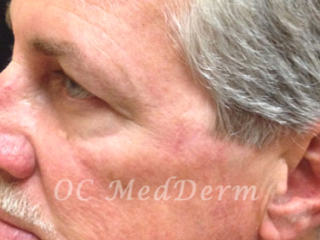Dr. Parvin Shafa a dermatologist in Irvine, Orange County CA is an experienced doctor in diagnosing and treating different types of non-melanoma skin cancers including Basal Cell Carcinoma (BCC) and Squamous Cell Carcinoma (SCC). If you have a skin lesion that is changing, bleeding, growing, or not healing, just call us to make an appointment for a skin evaluation.
Diagnosis and early cancer treatment is easy most of the time. Dr. Shafa is able to diagnose most skin cancers with the naked eye or with a dermoscope. If a skin lesion is suspicious, performing a skin biopsy is quick and effortless with minimal scarring, if any. Using anesthesia also allows the procedure to be pain-free. We are contracted with all types of PPO insurances, including Medicare. Ask questions or call us to make an appointment for a skin check.



Basal cell carcinoma (BCC) is the most common non-melanoma skin cancer. The lesion usually appears as a bleeding or scabbing sore that heals and returns. When left untreated, BCC can destroy the entire side of the face or eventually penetrate into the bone and brain. If you have a non-healing lesion of this type, it is imperative that you see a physician for evaluation and treatment.

Squamous cell carcinoma (SCC) is an aggressive skin cancer that is characterized by nodules and/or red, scaly patches that may form on sun-exposed skin (i.e. the ears, face, lips, and mouth). Although light and/or fair-skinned people are most prone to developing squamous cell carcinoma, people of all skin types must take precautions to limit sun exposure and get screened for any abnormal skin issues.


This is an actual patient of Dr. Parvin Shafa who was diagnosed with an SCC. Dr. Shafa removed the lesion completely with minimal discomfort and scar.
BCC is usually found on the face, head, and neck; location does not consistently correspond with areas of maximum sun exposure, unlike SCC. One third of BCC are found in areas that receive little to no exposure to UV light. SCC is usually found on the head, neck, and other areas that are most frequently exposed to the sun
Patients who have fair complexions are at high risk for SCC with no significant increased risk of BCC
Inability to tan is the highest risk factor for BCC. Old age and sun exposure over a lifetime are the highest risk factors for SCC
Both BCC and SCC are more prevalent in middle-aged or older patients
Having previously been diagnosed with a BCC or SCC increases your chances of being diagnosed with another of the same type of lesion
Having a member of your immediate family diagnosed with either BCC or SCC increases your chance of having the same type of lesion
Ask questions or Call us to make an appointment for your full skin check or evaluation of the skin lesion you are concerned about. We are contracted with all PPO insurances and Medicare.
Other Treatments
Skin Cancer Overview | Melanoma – Skin Cancer | Internal Cancers with Skin Manifestations
Book a consultation at OC Medderm | Irvineskin Today for Medical, Surgical, and Cosmetic Dermatology in Irvine & Orange County, CA.
We are experts in Acne, Pinch blepharoplasty, Ear lobe repair, Xanthelasma repair, Syringomas removal, mole removal, Keloid removal, Body and face piecing or piercing repair or removal, lump and bumps removal, Acne scar removal, Spider vein treatment, fungal infection, Co2 resurfacing, Warts and more.
You can schedule an appointment or call us now for all the dermatology treatments. We are located at 113 Waterworks Way 100, Irvine, Orange County CA, We Are Dedicated to Providing the Best & Transparent Dermatology Care for your skin.
Call us when you want!